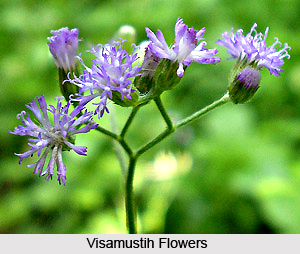Visamustih is an Indian medicinal plant that holds the scientific name Ageratum conyzoides. This plant has different names in different places. The plant is called `Dochunty` in West Bengal, `Mankdamari` in Gujarat, `Sahadevi` in Goa, `Muryampacha` in Andhra Pradesh, `Ghaneraosadi` in Maharashtra, `Boksunga` in Orissa and `Pumpillu` in Tamil Nadu.
 Visamustih is used generally for its medicinal properties all around India and possibly in other sub divisions of the country. This plant is found as a weed throughout the tropical zones of India though its native land was tropical America. In India it is found throughout most of the country. This plant grows commonly along roadsides, in open, damp habitats and as a forest understorey species to an altitude of 1800 metres. This weed is often found as weeds in tea, coffee and other plantations in southern India.
Visamustih is used generally for its medicinal properties all around India and possibly in other sub divisions of the country. This plant is found as a weed throughout the tropical zones of India though its native land was tropical America. In India it is found throughout most of the country. This plant grows commonly along roadsides, in open, damp habitats and as a forest understorey species to an altitude of 1800 metres. This weed is often found as weeds in tea, coffee and other plantations in southern India.
Visamustih is a polymorphic, aromatic, annual herb up to 1 metre tall, with decumbent stems. The young parts of the stem are hairy. The leaves are opposite or the upper alternate, broadly ovate or rhomboid-ovate to triangular. The size of the leaves varies from 2 cm to 10 cms and the width varies from 1.5 cm to 5 cms, apex subacute, have crenated margins, ciliate, base is cuneate, more or less hairy on both surfaces; the petioles are 2.5 cm to 3.2 cm long and hairy. The flowers of Visamustih plant are white, pale blue or violet in colour and do not have any odoriferous smell and contain 50 to 80 flowered heads. The fruits are black in colour, glabrous or thinly hairy, 2 mm to 2.5 mm long with awn-tipped, serrate pappus-scales. The plant generally bears flower that occurs throughout the year.
The leaves of Visamustih are considered useful as a drug that causes contraction of body tissues and canals. They are applied externally to promote healing of cuts and sores and to treat ague. Sometimes they are taken internally as a stimulant tonic. The leaves are used with salt as a vulnerary, and often used to cure tetanus. The leaves are boiled with oil and are applied externally to treat rheumatism.
The extraction of Visamustih herb is prescribed for the treatment of stomach ailments such as diarrhoea, dysentery and intestinal colic with flatulence, and for rheumatism and fever. The tribal inhabitants of Udaipur District in Rajasthan practice the oral consumption of dried powdered leaves to treat leucorrhoea. The tribal women of central Orissa, the pounded root is taken daily for a week after menstruation to treat dysmenorrhoea. The juice of the roots is considered antilithic. The flower buds of Visamustih plant are thought to be useful to reduce cancerous growths. The essential oil derived from the twigs of Visamustih plant is effective as an anthelmintic against tapeworms too.



















